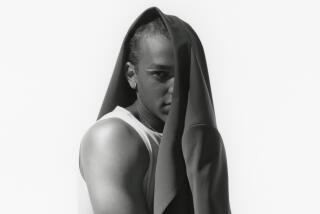Just add your own label
Gregory PARKINSON dresses fashion plates such as Brooke Shields and Shiva Rose. He’s shown his collection on the runway here and in New York. And he sells his color-drenched, vibrantly patterned clothes at some of the most exclusive stores in the world.
But today, he’s elbow deep in a spaghetti potful of purple dye, teaching us how to cook up spring’s coolest ombre pieces at home in the kitchen.
“This isn’t the tie-dye your parents wore,” Parkinson says in his quirky British accent.
No, it’s not. The spring runways proved that tie-dye today is as artful a form of decoration as hand-beading or embroidery. The old starburst patterns are gone, replaced by irregular stripes and arcs and watery rainbow effects. There are flowing ombre cocktail dresses at Diane Von Furstenberg, complex Japanese shibori patterns on circle skirts at Thakoon and dip-dyed scarves and sheaths at Matthew Williamson, mysterious and moody. For his own collection, Parkinson gave the tie-dye trend California ease with layered parachute silk tops, dresses and skirts in rich hues with subtle dyed details.
“Tie-dye is really like jewelry,” says the designer, who makes all of his tie-dye pieces by hand. “It’s surface decoration.”
Hippies took to tie-dye in the 1960s because it was a do-it-yourself, anti-commercial, anti-establishment venture, characterized by markings that are nearly impossible to replicate. Now, in an age when discount chains reproduce runway looks before they even hit stores, designers are turning to it again, to make things that are special, and to stay ahead of the copyists.
These are all subtle pieces, a far cry from the psychedelic spirals that graced Woodstock’s revelers. And the prices are a far cry from those T-shirt days too: $400 for simple pieces, and upward into the four figures.
But Parkinson let us in on a secret: The dying technique is as simple as it was in 1969. So simple that a beginner can transform a basic cotton shirtdress in less than 30 minutes.
“Once you master it, the possibilities are endless,” Parkinson says. He has the craft down to a science. After all, he’s always been fascinated by color and print, having cut his teeth at a London-based textile studio before moving to L.A. in 1989. After working as a stylist on music videos and commercials, Parkinson launched his line in 1994 with 15 hand-dyed dresses.
“I’ve probably spent hundreds of thousands of dollars on dye in the last 15 years,” he says. During the early part of his career, he tie-dyed every garment he touched. Colorful but shapeless dresses served as test canvases.
“They looked like clown clothes,” he says of those early “big, huge garments,” before starting to work on today’s canvas: A trim $24.99 H&M; shirtdress. He checks the label first: Dye doesn’t stick to polyester, so it’s imperative the garment be as close to 100% cotton as possible. At 97%, ours passes the test.
He begins by dying the dress pink, which will become the color of the “stripes.” Next, he loops and ties strips of muslin around the parts of the dress where he wants to place the “stripes,” to preserve the pink when he re-dyes the dress purple. This method of “tying-and-dying” is a form of shibori, an ancient Japanese art that uses dye-resistant materials to create intricate fabrics.
Parkinson wants to create a playful pattern and rich color. He pours the entire bottle of purple dye into the pot, crushing leftover clumps of dye with a large wooden spoon. “They cause splotches,” he says, stirring. Parkinson recommends that beginners use a three-pack of cheap T-shirts for a first draft. But he’s beyond trial and error, managing to conduct a conversation about India and check text messages in between steps. Parkinson dyes as many as 50 pieces at a time for boutiques such as Kirna Zabete in New York, Forty Five Ten in Dallas and Barneys New York.
Parkinson submerges the shirtdress into the pot of purple, stirring it occasionally, while being careful to keep it covered in liquid. After just a minute underwater, the dress is plucked from the pot, rinsed beneath the tap and squeezed dry.
Suddenly, it’s time for the big reveal. He unwinds the muslin strips -- so eager to see the results that he doesn’t even wait for the scissors. The decorous Englishman tosses civility aside and uses his teeth and . . . .
Faster than you can say “Purple Haze,” he shakes the rumpled ball of cotton, and a vivid pink and purple dress appears as if by magic. It’s stunningly good. And it took about 30 minutes, start to finish.
Actually, the result is so good that Parkinson seems a bit uneasy to have revealed his method for the world to try at home.
But can Michael Jordan create a protege by giving a basic basketball lesson? We think not.
--






